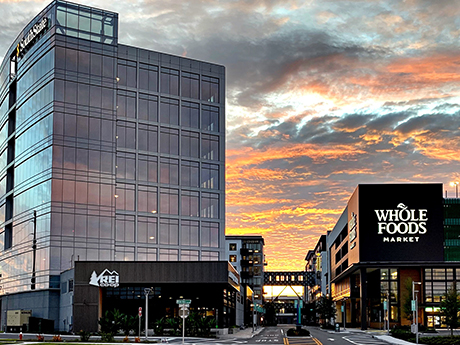By Nicholas Haines, CEO, Bromley Cos.
The desire to live close to everyday retail destinations — grocery stores, restaurants, gyms — isn’t new. But demand for this type of amenity has become increasingly popular with the rise of mixed-use developments.
Think about when you go on vacation. You pick a hotel or rental property that’s close to activities you want to do, sights you want to see or places you want to eat. Now, people are beginning to crave that same convenience in everyday life — and it makes sense.

Nicholas Haines, Bromley Cos.
While the pandemic blurred the lines between living, working and playing, rental communities that include residential, office and retail space have more than doubled in demand throughout the United States over the past decade. These units, also known as live-work-play (LWP) apartments, have seen a substantial increase in interest, especially among millennials.
Walkability is one of the primary traits that millennials seek when they’re searching for residential options, and LWP apartments present a unique opportunity to blend accessibility with desirable living experiences, world-class amenities, communal green spaces and exciting restaurant, retail and entertainment options.
LWP apartments have proven to be worthy investments, but just like with any other development, there are a variety of factors and market conditions to consider. When Bromley Cos. began its master plan for Midtown Tampa, a 1.3-million-square-foot mixed-use development in the heart of Tampa Bay, the firm had to take into account the demographics, physical constraints, opportunities, challenges and level of market demand for this type of product before jumping in.
However, Midtown Tampa has had tremendous success due to the time invested to understand the area, to curate the right mix of four major real estate classes and to introduce the unique concepts that Tampa previously lacked. While there’s no singular blueprint for creating a mixed-use development, here are a few tips and best practices to consider in order to set your live-work-play destination up for success.
Conduct Research, Location Scouting
As the name suggests, mixed-use developments require close evaluation of multiple asset classes. Developers must research everything from office, residential, hotel and retail uses to parks, benches, lighting and other design elements.
It’s an in-depth study and one in which corners shouldn’t be cut. And it’s essential to study macro- and micro-level trends that are influencing the landscape. Are people going into the office or working from home? What do population numbers look like and how have they changed over the past few years?
There are also topographical and regulatory factors that need to be considered. Height constraints, physical building restrictions and landscape capabilities are equally important. Another essential component is the city and public’s feelings toward development. Will the entitlement and zoning processes be easy or difficult? What about community meetings and public hearings? Taking all of these different components into account at the planning stages will help developers keep the asset relevant and running smoothly in the long run.
Our thesis for Midtown Tampa was that a dynamic, multi-use social and living destination would fill a void in the market. The construction and opening of the destination also came at an interesting time — a little over a year after the pandemic first wreaked havoc on the office and retail sectors. With the pandemic came substantial migration to Florida — one of the first states to reopen — creating a surge in interest from a retailer perspective.
Build for the Long Haul
While mixed-use developments have certainly gained traction in recent years, the property type is not new concept and won’t be going away anytime soon. It’s key to create buildings and spaces that are flexible and easily adaptable to changes in lifestyle or workplace mindsets.
For example, it might not be worth it to invest solely in Peloton bikes and treads, as that could be a trend that comes and goes. However, offering a variety of health and wellness amenities like weekly rotating classes, a built-out gym with yoga and strength capabilities or walking trails will serve developers well by appealing to a wide range of renter tastes.
Millennials are currently the dominant demographic interested in LWP apartments, but developers expect other age groups from mid-20s to active adults to increasingly explore these types of living situations.
Bromley has begun rolling out mixed-use developments in phases. With the first Midtown Tampa residential development, the units were priced at the highest rate in the market to attract affluent young professionals. However, we eventually expect to see the wants and needs of this demographic evolve.
Bromley currently has plans for a second residential development with bigger unit sizes, higher-quality amenities and more luxurious living for millennials who are transitioning into the family stage of life. These features will also appeal to older generations that want to make the move from a home into a resort-style apartment that offers quick access to everything.
Make Connecting Spaces Creative, Energetic, Intentional
Once the appropriate mix of uses is fleshed out, the focus shifts to creating the vibe and energy between the spaces. This initiative involves building community, fostering collaboration, creating memorable experiences and introducing a unique central gathering place to residents and visitors alike.
In Tampa, it is a breath of fresh air to be able to walk from a restaurant to a local shop to the grocery store to a nearby hotel without ever having to hop in your car. Art is also a major factor for us at Bromley, as it brings the space to life, allowing guests to notice something new each time they come back to the property.
Overall, Midtown Tampa is just one example of a successful mixed-use development. This model has been replicated across the country and will continue to provide many advantages to the community. Creating a walkable, dynamic and social place for people to come together to shop, dine, live, work, play and thrive has been a game changer for both urban and suburban lifestyles.
Nicholas Haines is CEO of Bromley Cos., a real estate and investment firm with a robust portfolio of office, retail, residential and industrial projects. Midtown Tampa has 550,000 square feet of office, 200,000 square feet of retail, a 225-key hotel and 700 residential units.


